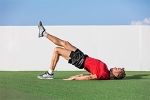Getting back in the game after a hip injury requires a focused recovery strategy. Many athletes push too hard too soon, leading to setbacks or re-injury. Understanding the key components of return-to-sport readiness can make all the difference. Let’s explore why strength, stability, and symmetry are essential after a hip injury.
Putting It All Together
The path back to sport isn’t just about “feeling good”—it’s about achieving performance and movement benchmarks that reduce the risk of re-injury and support long-term joint health. Whether you're a competitive athlete or an active adult, partnering with a specialist who understands sport-specific demands can make all the difference. Schedule a consultation with the hip specialists at AHI to explore a recovery plan built around your goals.
AUTHOR: Megan Flynn, MD, is a fellowship-trained orthopedic surgeon specializing in sports medicine, with a focus on soft tissue injuries of the knee, shoulder, and elbow. She has extensive experience caring for athletes at all levels—from professionals to weekend warriors. Known for her advanced training, compassionate care, and dedication to education, Dr. Flynn is committed to helping patients recover and thrive while also mentoring the next generation of physicians.
-
Strength: Rebuilding the Foundation
After a hip injury, the glutes, hip flexors, and core muscles surrounding the joint are often weak due to disuse or protective movement patterns. Regaining strength in these areas is vital to restore power, agility, and control.
Rehabilitation should include progressive strengthening exercises that target:
- Gluteus muscles for lateral control
- Hip flexors and extensors for stride power
- Core muscles to support pelvic alignment
A comprehensive strength program not only enhances performance but also reduces compensatory movement patterns that can lead to secondary injuries, particularly in the knees or lower back.
-
Stability: Control in Motion
While strength provides the force, stability ensures the hip joint is properly controlled through all ranges of motion. Athletes recovering from labral tears, impingement, or even arthroscopy must retrain neuromuscular control to maintain proper alignment during dynamic movements like cutting, jumping, or landing.
Single-leg balance work, proprioceptive drills, and dynamic stabilization exercises help the body re-learn how to move efficiently and safely. Stability is particularly important in sports that require quick directional changes or uneven terrain, where even a slight misstep can result in a reinjury.
-
Symmetry: Restoring Balance Between Sides
Returning to sport means your body should be functioning symmetrically under load and at speed. Muscle imbalances between the injured and non-injured side can affect running gait, stride length, and power generation, putting excess stress on compensating areas.
Assessment tools like gait analysis, hop tests, or strength symmetry evaluations help determine whether an athlete is truly ready to return to play. Athletes should aim for less than a 10% difference in strength and function between sides before resuming full sports participation.

